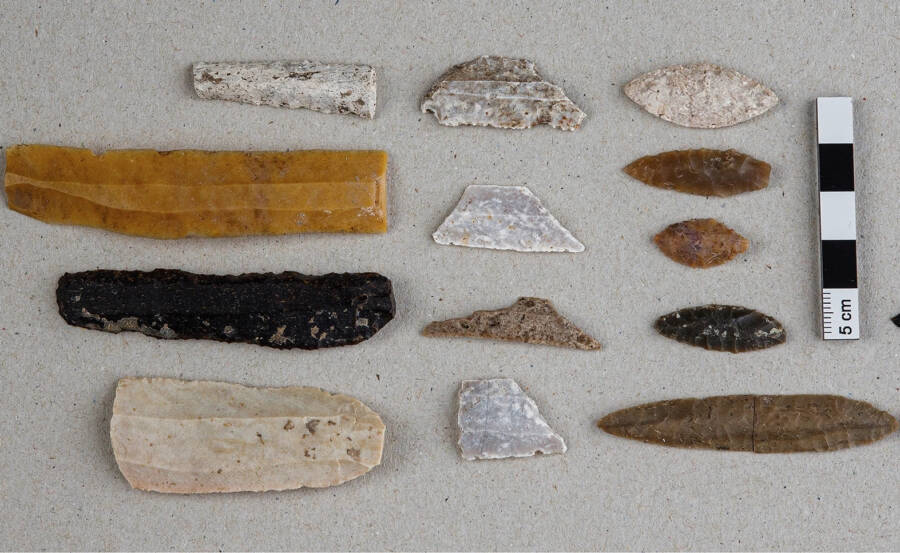Archaeologists say that the procedure bears striking similarities to ear surgeries still performed today, but that the patient would have likely endured "unbearable pain."

Scientific ReportsThis pile of ancient remains held evidence of the earliest ear surgery in history.
When archaeologists unearthed the Dolmen of El Pendón in 2016, they discovered the human remains of more than 100 people. Radiocarbon dating would reveal that the dig site in Burgos, Spain, had been used as a funerary chamber as far back as the fourth millennium B.C.E.
But it would take researchers until now to reveal the secrets of one unique set of remains — a 5,300-year-old skull that holds evidence of the earliest ear surgery in human history.
Researchers initially put the shattered skull in storage with the rest of the finds. In July 2018, archaeologists took a closer look and discovered it belonged to a woman likely between the ages of 35 and 50, old for the time. More remarkable was the presence of two perforations on each side of the skull around the ear.
According to a study recently published in Scientific Reports, “These evidences point to a mastoidectomy, a surgical procedure possibly performed to relieve the pain this prehistoric individual may have suffered as a result of otitis media and mastoiditis.”
In other words, the woman had an ear infection, and someone drilled into her skull to eliminate the infected tissue. “Given the chronology of this dolmen, this find would be the earliest surgical ear intervention in the history of mankind,” the authors wrote.
Comprised of experts from the University of Valladolid in Spain and the Spanish National Research Center in Italy, the team determined that the presence of bone regrowth around the holes indicated that the patient incredibly survived her excruciating surgery, which would have been painfully performed with primitive stone tools.

Scientific ReportsThe procedure required excruciating drilling and for others to restrain the patient.
Seven cut marks near the left ear canal revealed they were made by a skilled individual. According to Phys, the procedure bears striking similarities to today’s ear surgeries that are performed to clean out the inner ear area from infection. Failure can result in deafness or death.
“What we can say is that certain individuals would have attained a degree of anatomical knowledge and experience as ‘healers’ or budding physicians, if you like, to succeed in this kind of primitive healing,” said Manuel Rojo-Guerra of the Department of Prehistory and Archaeology at the University of Valladolid.
Rojo-Guerra and his peers confirmed that the patient had been a woman by the density of her skull and discovered her “old” age for Neolithic times by losing her teeth. It also appeared that the procedure failed to prevent infection, as her bone regrowth confirmed she died within weeks from likely infection.

Scientific ReportsThe ear surgery involved flint tools being heated to up to 350 degrees Fahrenheit before being used to scrape through bone.
“It is an elderly woman for the time, between 35 and 50 years old, who has two bilateral perforations compatible with two mastoidectomies,” he said. “The presence of these two types of structures in the microscopic preparation allows us to ensure that, for at least one month, the woman survived the surgical intervention.”
While it’s unclear if both perforations on each mastoid bone were carried out at the same time, the surgery would have been terribly agonizing. The surgeon likely spotted the infection with their own eyes before engaging in “progressive circular and abrasive drilling causing unbearable pain under normal conditions.”
Ultimately, the ear pain she hoped to relieve may have been minor compared to the procedure itself. Researchers discovered a flint blade nearby in the tomb that bore traces of cut bone on its edge and evidence of having been heated to between 300 and 350 degrees Fahrenheit. They believe the surgeon likely used it to cauterize the bone or bore into it.
Archaeologists say that several individuals would have had to restrain her so that she could withstand the surgery, or she may have taken mood-altering substances to endure it.

Scientific ReportsSigns of surgery on the ancient skull.
The Dolmen of El Pendón is an expansive single-chamber, multi-phase tomb used in funerary rituals for 800 years from 3800 to 3000 B.C. Rojo-Guerra and his colleagues Sonia Díaz-Navarro and Cristina Tejedor-Rodríguez have excavated this site for six long years and don’t plan to stop anytime soon.
According to The Daily Mail, the site itself underwent countless stages of use throughout its centuries as a ritualistic hub. Researchers noted in their study that it served as a “complex symbolic and ritual world” for those in the region at the time before it became a commemorative monument.
Ultimately, evidence of the earliest ear surgery in history might just be setting the stage for further discoveries at the site.
After reading about the earliest ear surgery in history, learn about the evidence of ancient Greek brain surgery. Then, read about the most painful medical procedures of medieval times.





